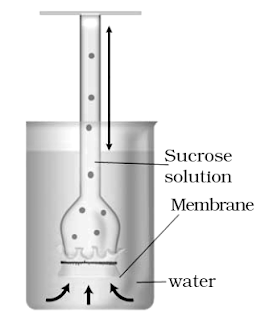2019 March (+1)
PART A: BOTANY
Answer all questions from 1 to 3. Each carries 1 score. (3 X 1 = 3) 1. Choose the correct answer.
A structure seen in bacterial cell is ..................
a. Nucleus
b. Lysosome
c. Plastid
d. Mesosome
2. Observe the relationship between the first two terms and fill in the blank.
a. Mushroom: Agaricus
Bread mould: .................
3. Fill in the blank.
Cytokinesis in animal cell takes place by the appearance of a ................... in the plasma membrane.
Answer any 9 questions from question numbers 4 to 14. Each carries 2 scores. (9 X 2 = 18)
4. Observe the figure given below:
Identify the process demonstrated in the figure. Write the role of membrane in this process.
5. Certain thylakoid pigments are called accessory pigments. Name them. Write their significance.
6. Notice the three simple tissues given below.
a. Sclerenchyma
b. Parenchyma
c. Collenchyma
Identify and write the tissue that consists of cells that are thickened at the corners. Write the function of this tissue.
7. Write any two differences between aerobic respiration and anaerobic respiration.
8. Observe the figure given below. It shows two phases in the life cycle of a plant.
Identify the phase marked as A. Write any two peculiarities of this stage.
9. Karyokinesis of mitosis is divided into four stages. Name the second and third stage. Write any two features of second stage.
10. Observe the figure given below:
Identify the parts a, b. Write their functions.
11. C4 plants have a special leaf anatomy. Name that anatomy. Write three peculiarities of this kind of anatomy.
12. Observe the figure given below.
Name the complex. Write its function.
13. Observe the elements given below.
Copper, Phosphorus, Boron, Magnesium, Potassium, Manganese, Chlorine.
Choose microelements from the above.
14. Match the items of column A with B.
|
A |
B |
|
a. Reduction |
i. Formation
of oxygen |
|
b. Photolysis |
ii. Formation
of 3-PGA |
|
c. Photorespiration |
iii.
Formation of PEP |
|
d. Carboxylation |
iv.
Formation of glucose |
|
|
v.
Formation of phosphoglycolate |
Answer three questions from 15 to 18. Each carries three scores (3 X 3 = 9)
15. Write three peculiarities of gynoecium seen in solanaceae and fabaceae.
16. Plant growth regulators perform various functions in plant body.
a. Name the hormones responsible for apical dominance and bolting. Define the two phenomena.b. Which plant hormone is referred to as an antagonist to gibberellic acid?
17. Names of three plants are given below.
a. Rhizophorab. Bougainvilleac. Pea
Name the modifications seen in these plants. Write their functions.
18. Observe the terms given below.
Xylem, Root hairs, Pith, Stomata, Cambium, Bulliform cells
From this, identify and write the structures seen in epidermal tissue system. Write their functions. (Hint: 3 structures).




